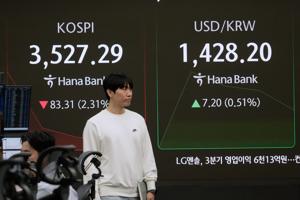U.S. stocks experienced a significant recovery on Monday, with the S&P 500 rising by 1.6%, marking its best performance since May. The Dow Jones Industrial Average gained 1.3%, while the Nasdaq composite surged by 2.2%. This upward momentum followed remarks from President Donald Trump that softened his earlier harsh criticism of China, which had previously rattled markets.
Investors reacted positively to Trump’s statements made on his social media platform, where he assured that “it will all be fine.” Just days earlier, he had threatened to impose much higher tariffs on Chinese imports, prompting a sell-off in stocks that culminated in the S&P 500’s worst drop since April. His comments indicated a shift from a confrontational stance, as he emphasized a desire to help China rather than harm it.
In a notable change of tone, Trump referenced that China’s leader, Xi Jinping, “doesn’t want a Depression for his country,” echoing a sentiment that aimed to ease tensions. The President’s earlier accusations against China included labeling its actions as a “moral disgrace” and expressing concerns over an “extremely hostile letter” from China regarding export restrictions on rare earth materials.
China’s response to the situation involved a call for negotiations rather than threats, with the Commerce Ministry stating, “We do not want a tariff war but we are not afraid of one.” This diplomatic overture raised hopes that the trade relationship between the two largest economies could stabilize, allowing for smoother global trade.
Market Dynamics and Influences
The stock market’s fluctuations reflect a broader trend of volatility experienced in previous months, particularly during April when Trump announced global tariffs. Market analysts, including those from Morgan Stanley, suggest that if tensions continue to subside, it could lead to a protracted recovery, potentially extending into 2026.
Stock prices had already been under scrutiny due to a rapid increase of approximately 35% since April, raising concerns about their sustainability. Despite the recent gains, critics point out that the market may appear overvalued, especially given rising anxieties surrounding companies in the artificial intelligence sector, where comparisons to the 2000 dot-com bubble have emerged.
The surge in stocks was also driven by optimism surrounding advancements in artificial intelligence. For instance, Broadcom experienced a remarkable increase of 9.5% following its announcement of a partnership with OpenAI to develop custom AI accelerators.
As the earnings reporting season approaches, major U.S. firms, including JPMorgan Chase and Johnson & Johnson, are expected to disclose their profits for the summer quarter. These reports will be scrutinized closely, as analysts predict that the overall profits of S&P 500 companies might surpass expectations, buoyed by a resilient U.S. economy and the weakening of the U.S. dollar against other currencies.
Global Market Reactions
Internationally, stock markets showed mixed responses. European indexes edged upward following losses in Asia, where markets had the first chance to react to Trump’s tariff threats. In Hong Kong, stocks fell by 1.5%, while Shanghai saw a slight decrease of 0.2%. China’s recent report indicating an 8.3% year-on-year increase in global exports for September suggests that manufacturers are seeking new markets outside the United States.
As the situation continues to unfold, the interplay of U.S. domestic policy and international trade relations will remain critical in shaping market dynamics. Investors are keenly watching for updates that could further influence stock performance and economic forecasts in the coming weeks.







































































